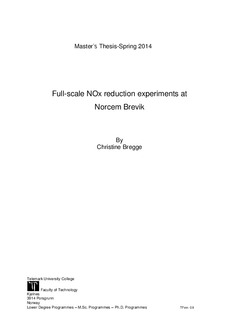| dc.description.abstract | The NOx reduction system installed at Norcem Brevik is based on the SNCR technology. It was installed in 2012 and substantial reduction of NOx has been achieved. However, it has never been performed experiments or optimizations of the system. SNCR technology is based on injection of a nitrogen-containing reduction agent, in this case ammonium hydroxide, to reduce the NOx concentration within the required temperature range, 1100-1400K (827-1127oC). The developed experiments were based on finding an optimal consumption of ammonium hydroxide and effective prescriptions combined with a fuel experiment, divided into two separate tests. During the experiments it was required to maintain a stable process in terms of raw materials, fuels, temperatures and flue gas. Stable conditions were maintained during the first test while at the second test disturbances occurred. The consequences were that the experiments had to be limited by excluding the planned fuel experiment. The temperature profile at Norcem is very low according to the SNCR technology and at one occasion the temperature dropped down to 820oC. As expected, the NOx concentration raised to a very high level. This confirms that the temperature is a very sensitive factor related to NOx reduction. NOx is reduced to a greater extent by injecting a larger amount of ammonia. There was found an economical- based optimum amount of ammonia at 150l/h and a reduction efficiency of 46.2%. The most effective nozzle combination obtained was three activated nozzles at only downstream of the precalciner with a reduction efficiency of approximately 40 %. The ammonia-slip depends upon two main parameters; amount of ammonia-injected and NOx concentration. Increased flow of ammonia caused increased ammonia-slip. When NOx was reduced to a lower level than 100mg/Nm3, ammonia-slip was rapidly increased. Maintaining an average flow of ammonia at 150l/h leads to a NOx concentration in the range of 150-175mg/Nm3 and a cost of 1.735MNOK/year. This is based on standard clinker production and is expected to be different when producing other types of clinker. Expenditure of ammonia was compared with corresponding NOx taxes. An optimum of 280l/h where found. At a higher average consumption than 280l/h it will be more profitable to pay taxes. This requires that NOx emissions are at the same level, about 190ton/year. This indicates a maximum expenditure of 3.2MNOK/year. | |
